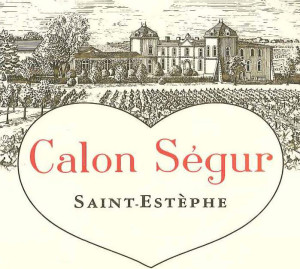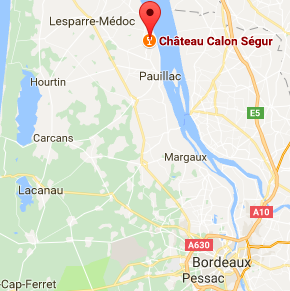
Overview

The Bordeaux wine property Calon-Ségur was named after a small river skiff used in the Middle Ages to ferry timber across the Gironde estuary. This eventually inspired the name of the district which was at one point known as Calones or St. Estèphe de Calon.
Historic records show the estate was in existence as far back as 1147 when it was owned by Monseigneur de Calon, an important bishop in the community. Eventually, the Medoc property came to be owned by Nicolas Alexandre de Ségur. After being passed from generation to generation, the estate became the property of the famous Marquis de Ségur. Marquis de Ségur was an important figure, not only for his ownership of the better Bordeaux estates of the day (Lafite and Latour), but for his long-lasting impact on the estate. He is quoted as saying “I make my wine at Lafite and Latour, but my heart is in Calon.” That famous phrase lives on in the label of Chateau Calon-Ségur, where the drawing of a heart is prominently featured on the logo.
Château Calon-Ségur was once one of the original three Bordeaux wine vineyards in St. Estèphe. In 1825, Château Montrose was a parcel of forest belonging to the Calon-Ségur estate, similar to its near neighbor-Phelan Ségur-which was also once part of the great Ségur estate. Those holdings were so vast they included not only Lafite, but also Latour and Mouton! This was in the 18th century, at which point Calon-Ségur was already an ancient estate, having been in existence for at least five hundred years.
The modern era for Chateau Calon-Ségur began in 1894 when its Medoc vineyards were purchased by Georges Gasqueton and Charles Hanappier. The Gasqueton family managed the estate until 2012. More recently, the figurehead of Calon-Ségur was the charming, albeit eccentric, Madame Denise Gasqueton. She ran the estate while marching to the beat of her own drum until she passed away at the age of 87 in late September 2011. The following year, in July of 2012, Chateau Calon-Ségur was sold for 170 million euros, or approximately 215 million dollars. The buyer was the large French Insurance company, Suravenir. Jean-Pierre Moueix, the owner of Petrus and the massive negociant company Duclot, took a minority stake in Chateau Calon-Ségur.
The style of Calon-Ségur wine is masculine and sturdy. It is tannic, structured, and traditional in its textures with a brawny body that often takes over a decade or two to become civilized.
The 131 acre Saint-Estephe vineyard of Calon-Ségur is one of the few remaining walled-in vineyards of the entire Bordeaux appellation. The vines are on average about 35 years of age, and are composed of 65% Cabernet Sauvignon, 20% Merlot, and 15% Cabernet Franc grapes. The soils are a mixture of gravel, clay, and sand. Production for Chateau Calon-Ségur is, on average, close to 20,000 cases per year. There is a second wine, Marquis de Calon. The owners also control a cru bourgeois property, Chateau Capbern Gasqueton.

Chateau Calon-Ségur Saint-Estèphe
Appellation: Saint-Estèphe. Third classified Growth in 1855.
Oenologist: Éric Boissenot
Soil: A thick layer of gravel laid down during the Quaternary Period. Predominantly clay sub-soil from the Tertiary Period. At the summit of the gravel deposits, there is also a fine layer of clay of lacustrine origin.
Vineyard Area: 55 ha (136 acres)
Planted Area: 45 ha (50 ha planted)
Grape Varieties: 53% Cabernet Sauvignon, 38% Merlot, 7% Cabernet franc, 2% Petit Verdot
Average Age of Vines: 22 years
Training Method: Double Guyot
Planting Density: 8,000 vines/ha
Target Yield: 45 hl/ha
Harvest: Manual; grapes are sorted twice, first by mechanical vibration, followed by hand sorting
Vinification: Temperature-controlled conical stainless-steel tanks. Maceration for 18 to 21 days
Aging: 17 months, 30% new barrels. Fining with egg white.
Average Annual Production: 80,000 bottles

Le C De Calon Ségur Saint-Estèphe
Overview: An integral member of the Calon Ségur family, the third wine exhibits a freshness and fruitiness geared for immediate enjoyment. It is mainly sourced from the estate’s young vines with a balanced blend made up of Merlot and Cabernet Sauvignon.
Formerly known as La Chapelle de Calon, then Le Saint-Estèphe de Calon Ségur, it took a new name with Le C de Calon Ségur since the vintage 2019. C like the third letter of the alphabet, for the third label of the estate. C like “Coeur”, the heart, symbol of the love carried by the Marquis de Ségur to the domaine, and singular distinctive sign of our bottles. C like Calon.
Appellation: Saint-Estèphe
Consulting Oenologist: Éric Boissenot
Soil: A thick layer of gravel laid down during the Quaternary Period. Predominantly clay sub-soil from the Tertiary Period. At the summit of the gravel deposits, there is also a fine layer of clay of lacustrine origin.
Vineyard Area: 55 hectares (136 acres)
Production Area: 45 hectares (50 ha planted)
Grape Varieties Planted: 57% Cabernet Sauvignon, 34% Merlot, 7% Cabernet Franc, 2% Petit Verdot.
Average Age of the Vines: 20 years old
Pruning Method: Double Guyot
Plant Density: 8,000 vines/hectare
Harvest: Hand picking. A first selection of grapes on the vine. Mechanical sorting of the grapes by vibration, followed by hand sorting.
Vinification: Temperature-controlled tronconical stainless-steel tanks. Vatting period for 18 to 21 days. Microbubbling. Co-inoculation, exogenous yeast and bacterias, in stainless steel tank at 25°C.
Aging: 16 months in 3 year barrels. Fining with egg white.


